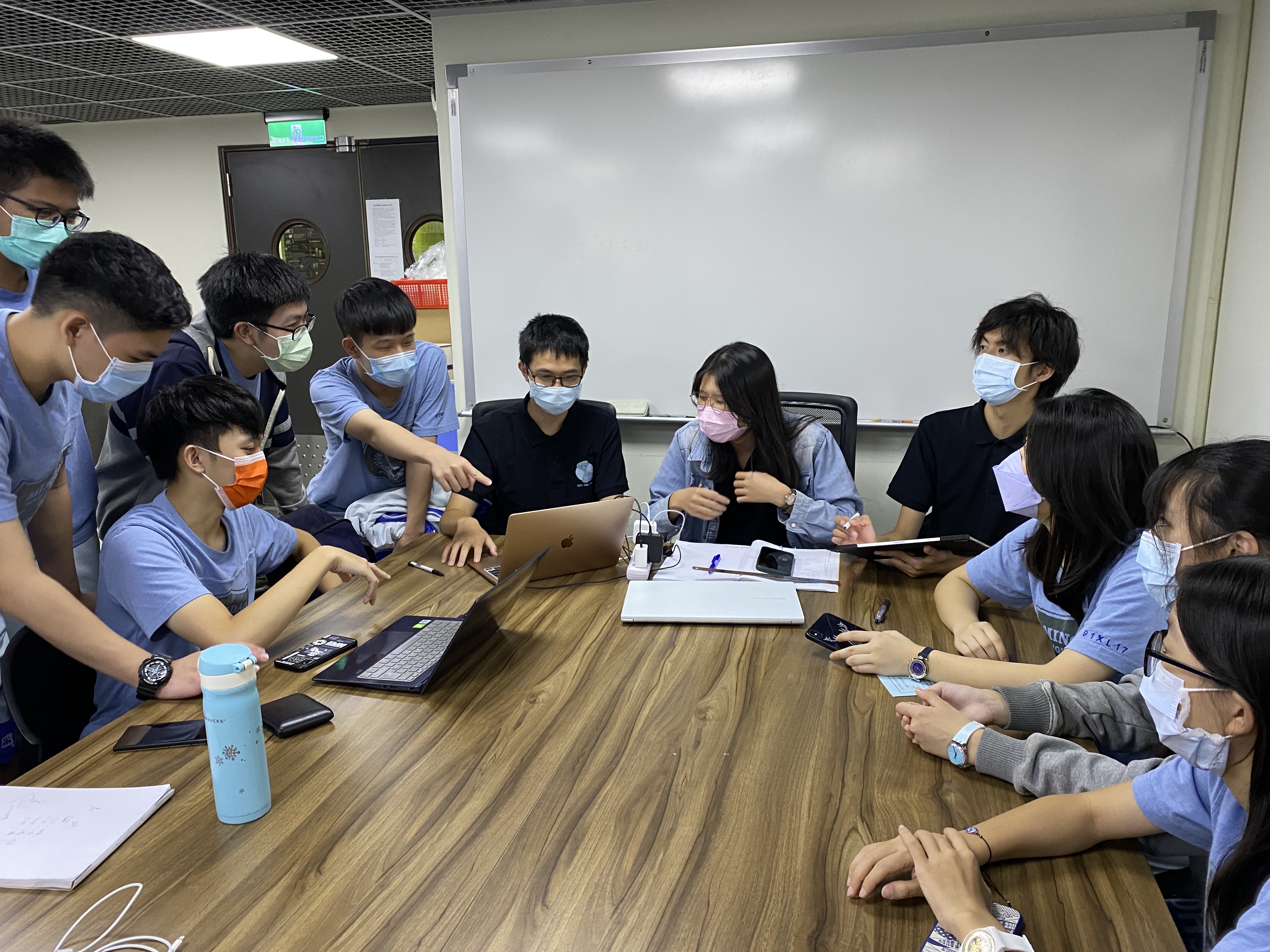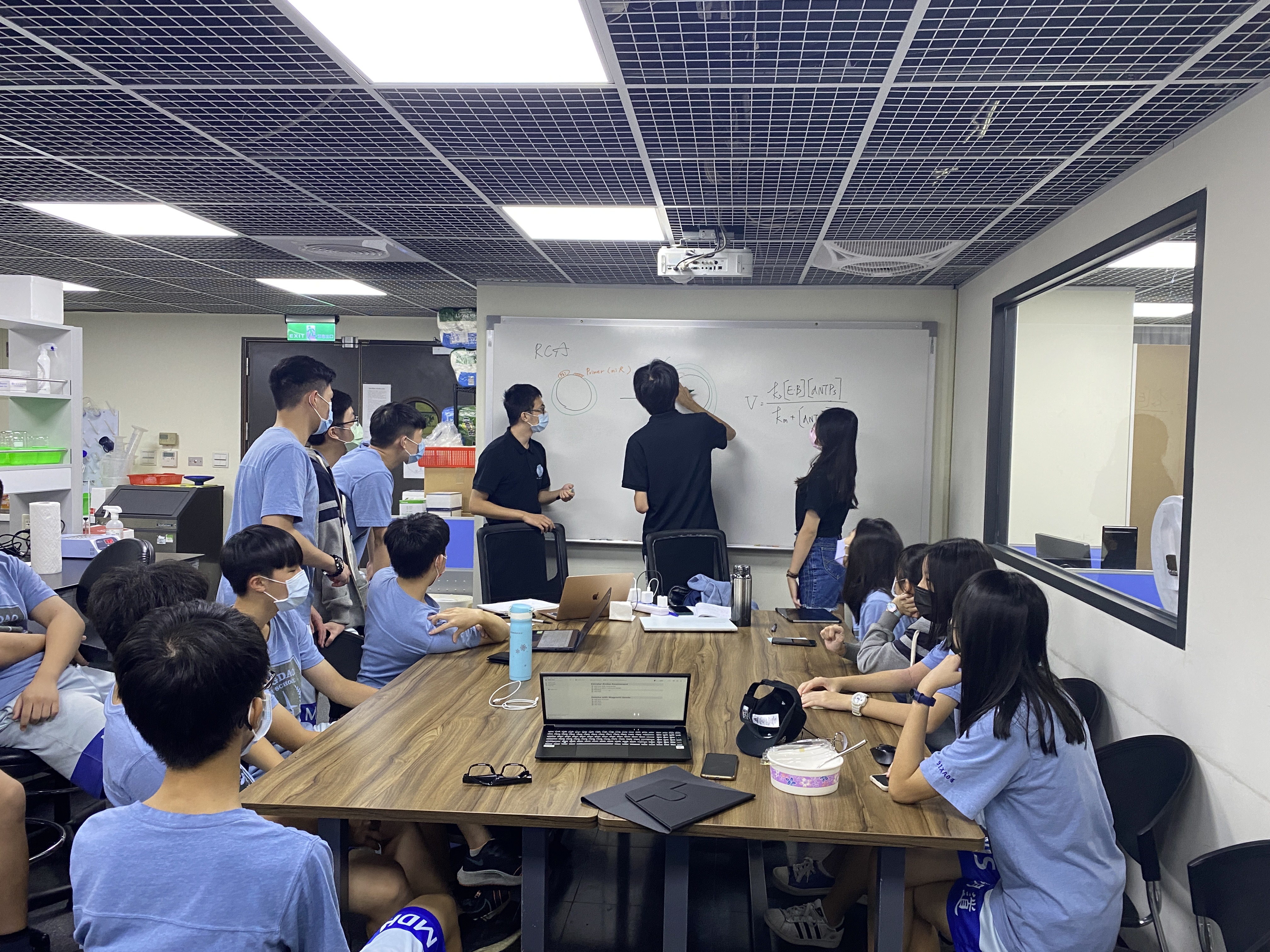PARTNERSHIP
Human PracticesEducation
Communication
Collaborations

Beyond Collaboration, we hope that through partnerships, not only will we gain sufficient knowledge in the field of synthetic biology, we can also build connections with people of different races and backgrounds and learn from each other. For our long-term partnerships, we partnered up with team CSMU_Taiwan and team TAS_Taipei, both of which were multimodal, meaning both teams benefited in our experiments, knowledge on synthetic biology, collaborations, educational projects, and even SDGs!
At the beginning of this summer, our team reached out to a local nearby collegiate iGEM team, Chung Shan Medical University (CSMU_Taiwan), wishing for a chance for collaboration. After the first online meeting, in which both teams shared their own projects and shared the bottlenecks they encountered, we discovered that we had many similarities in both of our experiments. Based on this similarity, we reached a consensus that we can help each other along the journey. Our collaborative project includes five stages, they are: phi29/RCA workshop (Mingdao to CSMU_Taiwan), linkage with a local hospital for food poisoning studies (CSMU_Taiwan to Mingdao), discussion on the circularization of linear ssDNA probe (Mingdao to CSMU_Taiwan), three-day workshop on lab skills (CSMU_Taiwan to Mingdao), and collective education project (Mingdao to CSMU_Taiwan).

Firstly, the phi29/RCA workshop given by us to CSMU_Taiwan. In their beginning stages, they were troubled with the amplification of the significantly
small amount of microRNAs in human blood serum, the “signal” was too small to be detectable. After hearing their problem during our first meeting, we immediately suggested they consider what our team decided to use.
We introduced them to phi29 DNA polymerase and how it’s related to Rolling Circle Amplification, the amplification process of a short DNA/RNA primer, forming a long single-stranded DNA/RNA. This helps with the detection
process as there are now more reactants to magnify the “signal”. We invited them to our school and made a presentation introducing them to the technique, while also letting them monitor how we apply this technique to our
experiment. The implication of this technique is found crucial to their project, helping them on the UTUC detection.


Secondly, team CSMU_Taiwan came back with a surprise by linking us up with their associated hospital, Chung Shan Hospital, after hearing our difficulties in finding a
reliable database regarding cases of food poisoning caused by Salmonella. Back in the time when this linkage took place, we were still uncertain about our topic, we weren’t quite sure whether this topic was more severe
and worldwide than the other one we were considering before. The data they gave us shows that Salmonella often ranks first or second for the main causes of food poisoning around the world, and was ranked third in Taiwan
in 2013 and 2014. With an infection rate of 0.41%, our decision was made immediately-- to tackle the issue of Salmonella. Beside providing us with reliable data, we also arranged a consultation with doctors in the Chung Shan Hospital.
During that consultation, we gained a better understanding of why Salmonella is such a mainstream cause for food poisoning. Moreover, we learned how Salmonella appears on food, and how they infect people, helping us to break down the problem.
Eventually, after the lectures, we narrowed down on where to tackle the problem as we started to understand its weaknesses.


Our collaboration doesn’t end here. After passing down the solution for their UTUC detection, CSMU_Taiwan encountered another problem. They were troubled with the different
ways to circularise the linear ssDNA probe. However, since we had previous experience with this topic, we helped analyze the different methods, including using the T4 ligase and ligation primer and Circligase. Together, we
contacted multiple international biological supplies companies, asking their opinions on each of the methods, and their suggestions for us. Eventually, after contacting three companies, we came to the conclusion that because
most of the companies didn’t have much experience with Circligase and there were fewer experiments conducted using it, we suggested that they should try T4 DNA ligase and a ligation primer for ssDNA circularization as we not
only received first-hand information on the process of the experiment from the companies, there are more references on the net. During this specific experiment, we were able to learn things beyond our own field, not being restricted
to what our project is about. Being able to learn more about synthetic biology is always great.
In return, CSMU_Taiwan provided us with mentorship on the lab skills. Although we might have better understanding in certain areas, after all, they are still undergraduate students who have been working in labs for a much longer period of time than high school students. Plus the fact that we have some new additions to the team who lack some basic knowledge regarding lab skills so their help was deeply in need. They came to our lab and gave us a three-day workshop, in which they taught us some relevant lab skills that we needed for the execution of our project, from the use of pipettes for the newer iGEMers to gel electrophoresis. Moreover, they also helped us work on our modelling. Since most of the equations or mathematical problems required for modelling exceeded high-school level, we needed their help to help us target a specific concept of function that will be crucial for the kind of result we expect from our model. With their help, we were able to focus on an exponential equation that predicts the latent time of phage based on the variables of burst size and cell density (more in Modelling). This workshop was especially helpful as we have similar approaches to our experiments, so they knew what essential skills they must equip us with.


Finally, we came up with another plan to educate an elementary school near both of our schools, Jiu-De Elementary School, on synthetic biology, something that they’ll never learn in their curriculum.
This was originally intended for us to bring in our material for education (more at Education) for a test, but since a high school team like us may lack credibility in terms of educating the younger generation. Therefore, we partnered up with CSMU_Taiwan
once more on another small educational experience. After discussions made with the administrators in Jiu-De, they agreed on bringing their students directly to our lab to pay for a visit while also having a quick one-day lesson on synthetic biology.
Using the material (board game) we were able to educate them on how bacteriophage has heavily impacted on our project and how it plays an important role in tackling all sorts of global issues (more at Education). For CSMU_Taiwan, although a part of our
project is similar, they were able to carry out a good fair amount of content for the kids. They taught them from basic biology to a little bit about synthetic biology, while also introducing the problem they are trying to solve with synthetic biology and
how it's helping them.


Overall, both teams helped each other with not only the experiments, but also basic lab skills, human resources linkage, and also education for elementary students. Our collaboration has been cross-sectional
and multidimensional, most importantly, it hasn’t been entirely for the sake of our experiment. Our collaboration was based also on helping each other to explore the world of synthetic biology and fields beyond what our projects cover; moreover, it was based
on spreading the sphere of influence of synthetic biology to the community, to our next generation.
Team TAS_Taipei has always been our main collaborator throughout the years, this year was no exception. Deeply inspired by their previous project (2020), we wanted to know more about Rolling Circle Amplification, something that their previous team has incorporated into their project. We reached out to them, hoping that a continuous collaboration can take place, which in fact did happen in the end. The collaboration process includes: the collaboration on our experiment and the collaboration on the newly-founded outreach project.
Firstly, the collaboration on our experiment. The approach we took to our problem was in fact inspired by the 2020 TAS_Taipei team. Originally, at the early stages of our experiment, we were faced with the problem of the insufficiency of the fluorescence of GFP carried by the phage, making the result undetectable. We then turned to the solution of phi29; coincidentally, the 2020 TAS_Taipei team dealt with this problem a year ago, so we reached out to them for further inquiry. This year’s TAS_Taipei, being the juniors of last year’s team, were kind enough to answer our requests by sending us the plasmid and their lab report for last year, giving us an opportunity to start ahead. To be more specific, they have provided 2 constructs: T7 + RBS SplintR ligase Expressing Construct (BBa_K3352006) and " T7 + RBS Φ29 DNA polymerase Expressing Construct (BBa_K3352007) (for more details and usage please visit Project and Parts). Another thing we learned from their past experience is their use of transposase in order to insert a DNA into the phage that has unknown DNA series. This technique is so crucial as it helps our salmonella phage to have phi29 DNA polymerase, the key to rolling circle amplification (RCA).
Secondly, the iGEMxSDG project. As its name suggests, it has to do with both iGEM and SDG; more specifically, it’s all about using our iGEM projects to reach the 17 Sustainable Development Goals. Participants of this project have to target their project to a maximum of three goals and then assign tasks for other teams to accomplish, the assigned tasks will have to be related to things that help your team to reach the goal. Basically, it is where all iGEMers gather around and work toward the 17 goals. It is crazy how synthetic biology can cover almost every goal! This was TAS_Taipei’s project that we also took a major part of. We tried our best to promote this and discussed with them the details of the event. Eventually, we got around thirty iGEM teams around the world participating in the event, with more than 50 tasks related to the SDGs completed. For example, one of our goals was to raise for the production of test kits to donate to local philanthropies and food banks, helping them to inspect their food that will be given out. This ensures that clean and healthy food can be sent out. Collectively, with the participants spreading this message to people around the world, we were able to raise around 5,000 NTD in only 4 weeks, giving us the opportunity to produce more test kits for the world. More of these were conducted around the world during this project, every team raised one or two goals for each other to help solve. Together, we make the world better through synthetic biology.


In conclusion, we partnered up mainly with team CSMU_Taiwan and team TAS_Taipei. With team CSMU_Taiwan, because we worked on similar topics, we helped each other with each others’ experiments through workshops, multiple visits, and hand-on demonstrations. With the last year team TAS_Taipei (2020) being our inspiration, we had continuous conversations and workshops with each other on the topic of phi29, while sometimes discussing how the iGEMxSDG project should be like. From experimental collaboration to spreading awareness, we were able to collaborate with multiple teams under this hard time; collaboration is something that should never be let go of when it comes to iGEM.